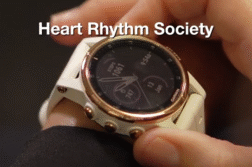CLEVELAND, Ohio. (Ivanhoe Newswire)— If you log onto your phone right now, what kind of information would you find? Your heart rate? How many steps you’ve taken? Or maybe you track how much sugar you eat? But what if you could also check your pacemaker? Nearly three million people worldwide have implanted electronic devices that they’ve never been able to track themselves … until now, ipacemaker.
Millions of people need surgically implanted cardiac devices, like pacemakers, to keep them alive. Close monitoring of these devices is critical.
Khaldoun Tarakji, MD, MPH, associate section head of cardiac electrophysiology at Cleveland Clinic told Ivanhoe, “They say, well, I know, doc, I know that you’re receiving my data, but I have no idea whether this is truly happening or not.”
But now, Dr. Tarakji has found a way to put that power in your smartphone. It’s a first of a kind app called MyCareLink Heart.
“Other people have to have a monitor beside their bed to record it and they have to take it in, and have it read where mine can be read at any time,” shared bradycardia patient Erma Mercer.
“It outperformed all the existent technologies for remote monitoring,” explained Dr. Tarakji.
Bluetooth wireless telemetry and new-generation pacemakers transmit data from the heart to a phone or tablet, then directly to the doctor.
“And we found that with this new technology, the success rate was high as 94.6 percent,” elaborated Dr. Tarakji.
No matter where you are.
“I just feel so much safer and so much better,” exclaimed Erma Mercer.
“We’re all attached to these devices. And this is not just for the care of the patient of today, but this is also for the care of the patient of tomorrow,” Dr. Tarakji explained.
While the MyCareLink Heart app improves outcomes for patients over other traditional methods of monitoring, the biggest challenge has been access to a smart device. To donate an old smartphone or tablet to someone in need consider logging on to sites like http://www.1millionproject.org/ or https://medicmobile.org/.
Contributors to this news report include: Cyndy McGrath, Executive Producer; Sabrina Broadbent, Field Producer; Roque Correa, Editor.
To receive a free weekly e-mail on Medical Breakthroughs from Ivanhoe, sign up at: http://www.ivanhoe.com/ftk
MEDICAL BREAKTHROUGHS
RESEARCH SUMMARY
TOPIC: iPACEMAKER: SMARTPHONES SAVING LIVES
REPORT: MB #4774
PACEMAKER: A pacemaker is a small device that helps your heartbeat more regularly. It does this with a small electric stimulation that helps control your heartbeat. Your doctor puts the pacemaker under the skin on your chest, just under your collarbone. It is hooked up to your heart with tiny wires. Impulses flow through the wires and lead to your heart. They are timed to flow at regular intervals just as impulses from your heart’s natural pacemaker would. Some pacemakers are external and temporary and not surgically implanted. There are three types of pacemakers and they are a single chamber pacemaker (carries electrical impulses to the right ventricle of the heart), dual chamber pacemaker (carries electrical impulses to the right ventricle and right atrium of the heart) and biventricular pacemaker (it stimulates the lower chambers of the heart – the right and left ventricle).
(Sources: https://www.heart.org/-/media/data-import/downloadables/c/3/3/pe-abh-what-is-a-pacemaker-ucm_300451.pdf, https://www.mayoclinic.org/tests-procedures/pacemaker/about/pac-20384689)
TRADITIONAL REMOTE MONITORING: Until 1989, data was centrally registered by sending a carbon copy of the pacemaker card to the registry. From 1989 onwards, digitalized registration was used with automatic communication between the central registration computer and the local computer of the implanting center. During the daily conversions to the database, multiple checks were performed on missing data, conformation with already stored information and plausibility. Additionally, the data was periodically returned to the clinics for correction purposes. The data downloaded from the device by the transmitter is then sent to the physician, using either the landline phone or the GSM network. Remote monitoring, which concerns data acquired automatically daily by the device, with unscheduled transmission of any pre-defined alerts to the physician. These alerts may involve device integrity like battery status and lead impedance, programming issues like disabling of ventricular fibrillation therapy, insufficient safety margins for sensing, capture, or medical data including arrhythmias and indications of lung fluid accumulation.
(Sources: https://www.ncbi.nlm.nih.gov/pmc/articles/PMC5179359/, https://www.ncbi.nlm.nih.gov/pmc/articles/PMC2686319/ )
NEW REMOTE MONITORING TECHNOLOGY: The international BlueSync Field Evaluation found that patients with implanted cardiac pacemakers using a smart device app for remote monitoring resulted in a significantly higher rate of scheduled transmission success compared with traditional manual and automatic bedside monitoring technologies. Medtronic’s BlueSync technology employs low-energy Bluetooth wireless telemetry to allow patients to use their own smart device, whether a smartphone or a tablet, to directly monitor their new-generation pacemaker or biventricular pacemaker. Patients can leverage an app-based platform, the MyCareLink Heart™ App, that can transfer pacemaker data to patient management networks, such as CareLink™, without the use of a traditional bedside monitor. End-to-end encryption keeps the pacemaker data secure. Dr. Khaldoun Tarakji, Associate Section Head of Electrophysiology at the Heart and Vascular Institute at the Cleveland Clinic and the study’s principal investigator says “This study shows that long-term follow-up with BlueSync-compatible pacemakers using an app-based platform produces a higher rate of success in scheduled transmissions compared with traditional remote monitoring options”.
FOR MORE INFORMATION ON THIS REPORT, PLEASE CONTACT:
ANDREA PACETTI
CLEVELAND CLINIC
216-316-3040
If this story or any other Ivanhoe story has impacted your life or prompted you or someone you know to seek or change treatments, please let us know by contacting Marjorie Bekaert Thomas at mthomas@ivanhoe.com




